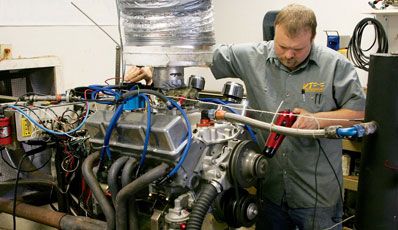
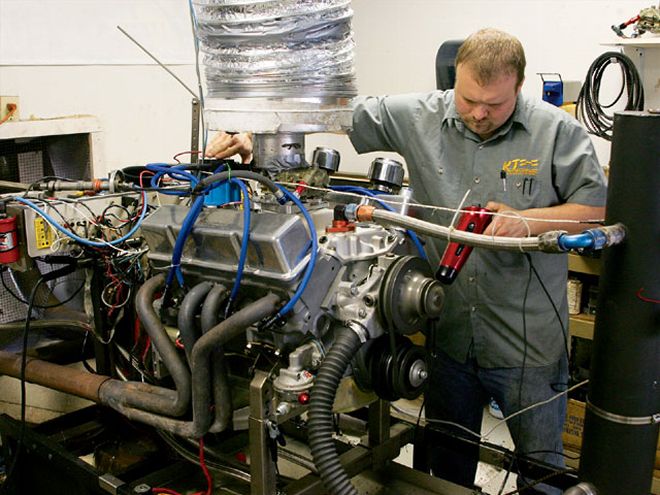
There are a few things in engine building that are obvious when it comes to making power. Lightweight pistons and rods make power. Efficient combustion chambers and well-designed CNC ports make power. It's even obvious that racing oil pans with windage trays and kickouts make power. But does the ignition you use make power? After all, as long as the spark plug fires, that's all you can do, isn't it?
There is only one way to find out for sure.
Many Street Stock racing classes limit the ignition to stock-style replacement parts. For most Chevrolet and Ford engines, this means an HEI distributor is the only option. An HEI distributor is a great piece of equipment for an over-the-road car because it is completely self-contained. It requires minimal wiring and is easy to install. But without an external coil, a stock HEI cannot provide a strong spark at rpm levels commonly seen on the racetrack. Engines with higher compression or more horsepower also require a hotter spark.
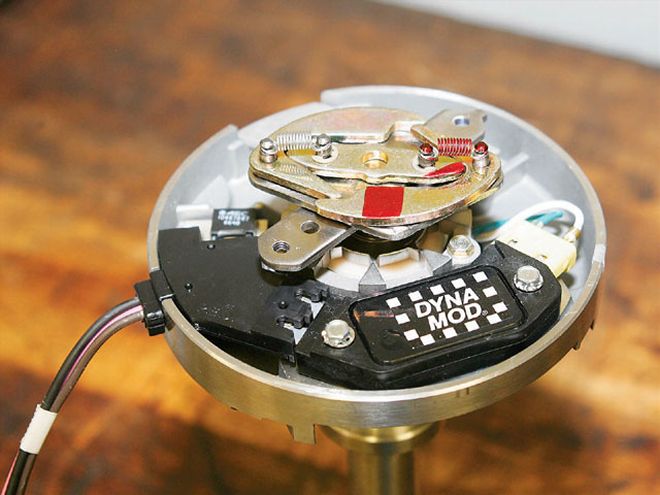 One of the secrets to Performance Distributors' HEI ignitions is the high-power, low-resistance modules used to maintain a strong spark long after a stock ignition can no longer keep up.
One of the secrets to Performance Distributors' HEI ignitions is the high-power, low-resistance modules used to maintain a strong spark long after a stock ignition can no longer keep up.
Thankfully, modern technology provides an answer. Companies like Performance Distributors produce a race-quality HEI. The greatest differences can be found in an efficient module and the self-contained coil, which is capable of putting out much more power with less dwell time. Performance Distributors also custom tailors the advance mechanism around the needs of the engine. The result, we have been told, is a race-legal distributor that can provide a strong spark up to 9,000 rpm. By comparison, a stock HEI will have a race engine skipping and starving for power at 6,000 rpm.
To see if the distributor actually makes a difference, we traveled to KT Engine Development in Concord, North Carolina. Shop owner Ken Troutman was putting the finishing touches on a perfect dyno mule for our test. This Limited Late Model races at a track where the rule book specifies no external box or coil. By default, this means some type of HEI must be used.
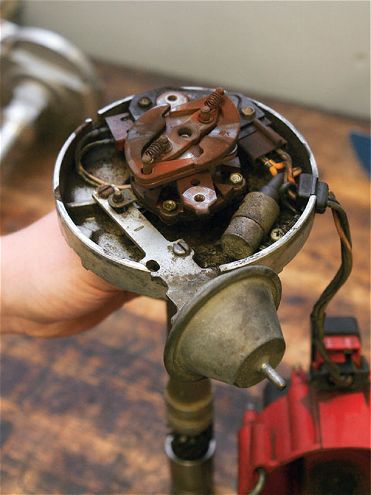 The stock HEI we planned to test was one that KT Engines' owner, Ken Troutman, just happened to have on hand. After a quick inspection, it was very obvious that this unit needed a little refurbishment in order to make the test fair.
The stock HEI we planned to test was one that KT Engines' owner, Ken Troutman, just happened to have on hand. After a quick inspection, it was very obvious that this unit needed a little refurbishment in order to make the test fair.
The engine for our test is the perfect candidate because it should be capable of big power and able to stress any ignition. The Chevy 350 has a 4.040-inch bore and 3.480 stroke. It is equipped with a flat-tappet cam with solid lifters. Total valve lift is 0.485 inch, and engine compression is 10.8:1. It has stock-style 23-degree heads, with 62cc combustion chambers and flat-top pistons. The Holley 500-cfm two-barrel carburetor is track mandated. The engine made peak power with both ignitions at 31 degrees advanced, so that became our fixed setting for the duration of the test. Finally, it has been outfitted with Autolite AR13 spark plugs gapped at 0.035 inch.
After properly breaking in the motor, we decided to begin the test with a stock HEI. Troutman had a stock unit that had been pulled from another engine that we initially planned to use. But a quick inspection of this unit showed that it was a bit worse for wear. To ensure that the test was fair, we had to make this distributor as good as new, or better. So, before it ever saw action, the stock distributor was treated to a new rotor, cap, and module. Only then did we consider it ready for service. Also, to make sure we weren't mistaking a problem with the stock ignition for something that was really the fault of poor plug wires, we ran the same set of Performance Distributors LiveWires for both tests.
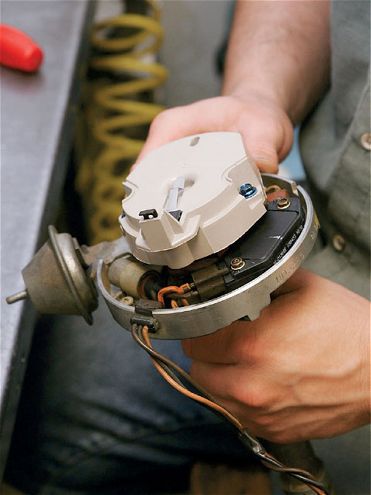 After installing a new cap, rotor, and module-in addition to a good bit of cleaning-the stock HEI's performance was back to like-new condition.
After installing a new cap, rotor, and module-in addition to a good bit of cleaning-the stock HEI's performance was back to like-new condition.
On the dyno, the stock ignition functioned about the way we expected. It performed well up to approximately 5,500 rpm. After that, the ignition could no longer keep up with the engine's needs. The dyno results showed sudden dips in horsepower because the engine was misfiring. It was also quite obvious when the engine began skipping and misfiring.
Next came Performance Distributors' race-built ignition. The ignition has the same physical dimensions as a stock unit; if you order the black cap, it can easily pass as stock if your rule book requires that. We made no changes to the engine other than installing the new ignition. Oil and water temps were held within a set 10-degree range during all tests for consistency.
Like all DUI ignitions, ours arrived with advance curves customized for our engine. It also had the vacuum advance blocked off to simplify operation for racing. But the real difference is the performance coil, which features updated materials and windings versus the stock coil. The result should be less resistance to the electrical charge being generated. This means the coil charges faster and transfers more of that energy to the spark plugs.
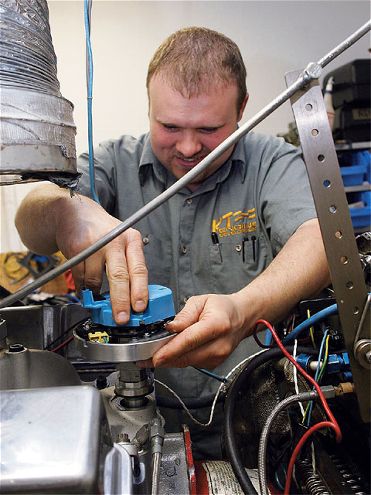 No changes were made between tests, other than swapping out distributors. Kevin Troutman set the timing on both to 31 degrees advanced, and the mechanical advances in both units were fully engaged by the time the dyno began recording numbers at 3,900 rpm.
No changes were made between tests, other than swapping out distributors. Kevin Troutman set the timing on both to 31 degrees advanced, and the mechanical advances in both units were fully engaged by the time the dyno began recording numbers at 3,900 rpm.
The module is also specialized for racing. The ignition module is the equivalent of the system's brain. It controls the current sent to the coil. Obviously, if the coil is fed a higher current it can continue to send the proper amount of energy to the plugs, even when high rpm levels significantly cut into the dwell time. (Dwell is the amount of time the coil has to recharge between firing the spark plugs.) It is also possible to use this module to increase the duration of the spark, or even act as a rev limiter.
This time, the engine ran strong all the way through the dyno sweep. The dyno results showed a much smoother horsepower graph, and it sounded much healthier. Best of all, maximum power with the stock distributor was 401.7 hp at 5,900 rpm. The DUI distributor not only smoothed out the power dips that plagued the stock distributor, it also bettered it by 2 hp, maxing out at 403.8 at 6,000 rpm. Although we are only displaying results from two dyno pulls, several pulls were made with both ignitions to ensure we were getting consistent results.
Honestly, in this test it was easy to determine the winner even before the dyno results were printed. Just by listening, it was easy to tell that the stock ignition, even with the fresh coil, cap, and rotor, was causing the engine to misfire and skip once the rpm exceeded 5,500. With the DUI, this simply wasn't a problem. Although our dyno sweep only goes to 6,400 rpm (because power dropped off significantly after that), Troutman says he has seen this ignition perform well to 7,000 rpm and beyond.
And even though we will never sneeze at an improvement of 2 hp, the biggest benefit of a racing-specific HEI ignition over stock is the ability to eliminate the dreaded high-rpm miss. Plus, for Limited Stock engines, there is no difference between the performance of this HEI ignition and that of a high-end unit with an external coil and brain box. In terms of both simplicity and performance, a racing-specific HEI ignition like this unit from Performance Distributors is really hard to beat.
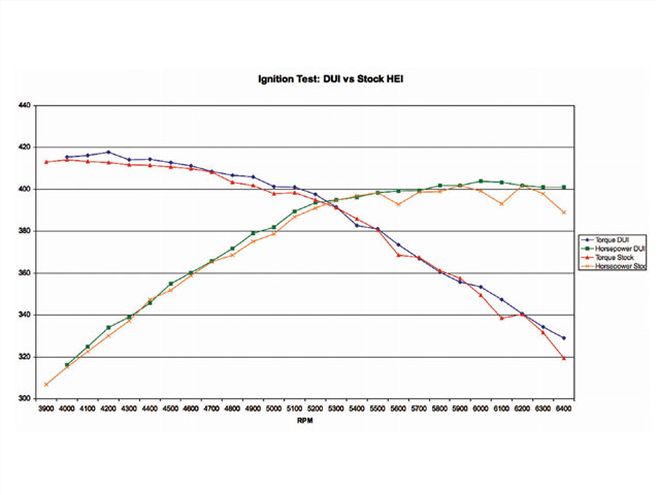 Ignition Test: DUI vs. Stock HEI
Ignition Test: DUI vs. Stock HEI
We've all heard that running thinner oil can help your engine make power, but how much is it really good for?
While we had our Limited Late Model Chevrolet race motor on the dyno, we wanted to squeeze all the information out of it we could. Between tuning sessions and after completing our ignition test, we begged engine builder Ken Troutman for extra dyno pulls.
One topic that often comes up during bench-racing sessions is motor oil. What kind is the best? Is it okay to break in a new engine with synthetic? How much oil pressure do I need to properly protect the engine? And then there's our personal favorite: How much is lightweight motor oil really worth in terms of power?
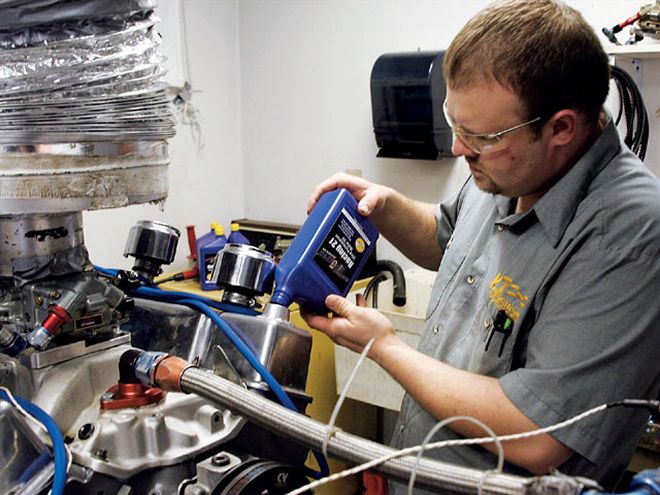 While we had a race engine on a dyno for our previous ignition tests, we also decided to sneak in a quick test to see how changing the viscosity of motor oil affected horsepower. Here, Kevin Troutman adds Royal Purple's racing synthetic for the second half of our test.
While we had a race engine on a dyno for our previous ignition tests, we also decided to sneak in a quick test to see how changing the viscosity of motor oil affected horsepower. Here, Kevin Troutman adds Royal Purple's racing synthetic for the second half of our test.
Our test engine is the same Chevy small-block used in the ignition test, so almost all of the stats for the engine are the same as listed there. The Performance Distributors HEI ignition was used for both tests. The only significant difference is we switched carburetors between the ignition tests and the following oil tests. This does not affect the numbers for the oil tests, so those can still be compared. However, it means you shouldn't compare dyno numbers between this test and the previous dyno session testing ignition systems.
Our baseline is a mineral-based oil with a 15W-40 viscosity. We chose this for several reasons. First, mineral-based oils are popular in Street Stock racing classes because they are significantly cheaper than synthetic oils. The 15W-40 viscosity is also a popular weight. Often, racers feel that if they are racing in a class in which stock-style engine components are required, there is little to be gained by a high-end racing oil. After all, if you are forced to use heavier rotating components and a standard oil pump, thinner oil would just be wasted, right?
Troutman assured us that although our test engine uses very nice internal components and the bearings clearances are all blueprinted and held to the acceptable minimums for good oil control, anything found on the dyno here would also apply to everything, all the way down to a completely stock engine.
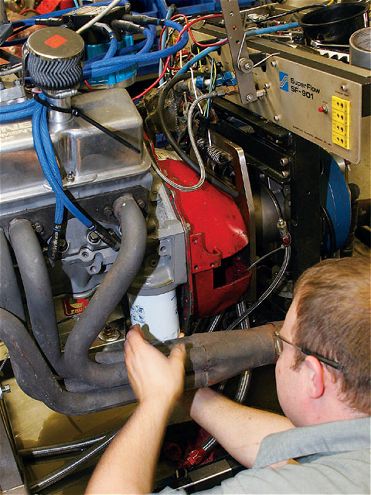 One of the greatest causes of resistance to the oil pump is the pushing of motor oil through the oil filter element. To replicate this with both oils, we removed the dyno's oil filtering system and screwed on new canister filters for each test.
One of the greatest causes of resistance to the oil pump is the pushing of motor oil through the oil filter element. To replicate this with both oils, we removed the dyno's oil filtering system and screwed on new canister filters for each test.
The biggest opportunity for saving power when switching to a lighter-viscosity oil occurs when the amount of energy required for the oil pump to move the oil throughout the engine is reduced. It only makes sense that a lighter-viscosity, or thinner, motor oil will be easier to pump. One of the major causes of internal resistance inside the motor is the pushing of oil through the oil filter element. Of course, that's certainly something you do not want to do without, so to simulate it accurately, we removed the dyno's built-in oil tank and Oberg filter and screwed a standard canister-style oil filter onto the block. A brand-new filter was used for each weight of oil. Also, there were 8 quarts of oil in the motor for both tests. The oil filter held approximately 1 quart, and the gated racing oil pan was rated for 7.
Beginning with the 15W-40 mineral-based oil, the engine was warmed up on the dyno until the water temperature was approximately 170 degrees F and the oil temperature was 200 degrees F. Once the engine was in the proper temperature range, dyno pulls showed peak torque at 408.4 ft-lb at 4,800 rpm, while peak horsepower was 402.4 at 6,000 rpm. At 3,900 rpm, the beginning of our dyno sweep, oil pressure inside the galleries was 63.1 psi. It peaked at 69.1 at 6,100 rpm.
After testing the 15W-40, we drained the oil pan, screwed on a fresh oil filter, and filled it back up with 8 quarts of Royal Purple racing oil. Royal Purple has made its name in motorsports as a manufacturer of high-end synthetic lubricants. We used Royal Purple's Racing 21 brand, which the company describes as an ultimate performance motor oil. Its viscosity is rated at 5W-30.
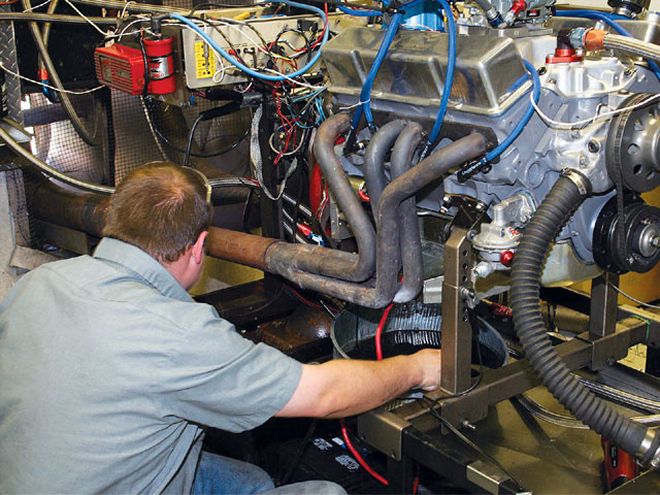 The 7-quart oil pan was well designed and included a windage screen. We are confident that windage played only a minimal role in determining the horsepower figures for this test.
The 7-quart oil pan was well designed and included a windage screen. We are confident that windage played only a minimal role in determining the horsepower figures for this test.
Like before, no dyno pulls were performed until the engine had warmed to the point that the water temperature gauge was reading 170 degrees and the oil temperature gauge was pointing at 200. This time, peak torque was 409.4 ft-lb at 4,800 rpm and peak horsepower was 407 at 6,200 rpm. In terms of peak power, that's an improvement of 1 pound of torque and 4.6 hp. Those numbers are fun by themselves, but what is even more impressive is that both the torque and horsepower numbers trended higher throughout the range with the lighter-viscosity oil.
Interestingly, peak oil pressure for the 5W-30 Royal Purple was virtually the same at 68.5 psi at 5,800 rpm. But a closer look, comparing all pressures throughout the rpm range of the dyno pulls, revealed a clearer picture. The lighter-viscosity oil registered a slightly lower oil pressure in the lower rpm range. Then, it caught up with the 15W-40 oil around 5,800 rpm and stayed within a couple tenths of the heavier oil the rest of the way. Of course, what was really happening was the standard-pressure oil pump in the motor was going into bypass mode, causing the oil pressure during the dyno pulls for both oils to plateau at just under 69 psi. The heavier oil hit that plateau at approximately 5,600 rpm, while the Royal Purple caused the oil filter to go into bypass mode 200 rpm later. So, for our purposes, more information is revealed comparing the oil pressure numbers before approximately 5,600 rpm, when the bypass spring in the oil filter put a stop to our pressurized fun.
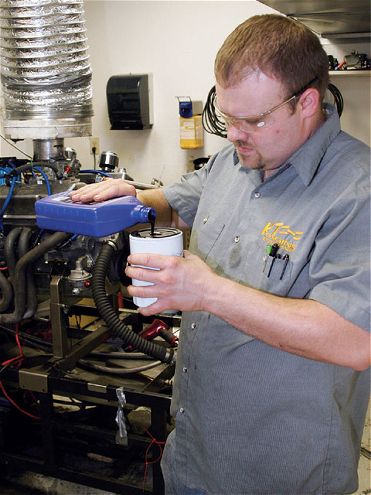 Whenever you change your oil filter, be sure to pour new oil into your new filter until it is at least 3/4 full before installing it. This will ensure your bearings won't be starved for oil while the oil pump fills the empty filter.
Whenever you change your oil filter, be sure to pour new oil into your new filter until it is at least 3/4 full before installing it. This will ensure your bearings won't be starved for oil while the oil pump fills the empty filter.
The viability of thinner motor oil to allow a race engine to produce more power is definitely not a myth. Gaining between 2 and 5 hp throughout your racing rpm range simply by swapping out the motor oil has to be one of the easiest power upgrades you can make.
Now, of course, the question becomes, how thin can I go with my motor oil before it can no longer do its job? After all, making sure your engine is properly protected from friction must still be your first priority. The answer to that question depends a lot on your engine. Troutman says that blueprinting every bearing clearance to minimum tolerances dramatically improves oil control to the point that you can safely race ultra-thin performance oils where a stock motor would quickly damage itself. This also requires intelligently sizing and placing oil restrictors in the engine to reduce oil flow where less is needed while maximizing pressure at the rod and main bearings. Certainly, a quality 5W-30 oil is safe in race engines that are well built and maintained, especially if you are always careful to properly warm the engine before hitting the racetrack. It is also possible to go even thinner, but before you do, take the time to talk it over with your engine builder and maybe even the tech support department of the oil manufacturer you choose to use.
The fact that we ran mineral-based oil in one test and synthetic in another probably had very little to do with the difference in dyno numbers. That's more the role of the different viscosities. The synthetic oil, however, does have advantages in that it is less susceptible to breaking down under high heat or extreme use. Because of this, when experimenting with light-viscosity racing oils, it is recommended to stick with synthetics. The extra protection a good synthetic can provide may be just the thing that allows you to run a super light oil while still adequately protecting your expensive race engine.
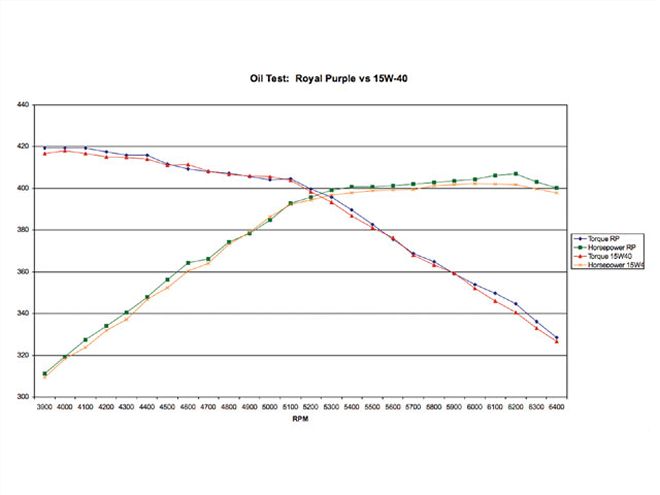 Oil Test: Royal Purple vs 15W-40
Oil Test: Royal Purple vs 15W-40
Until the oil pump's bypass kicked in at approximately 5,600 rpm, it is interesting to note how the Royal Purple 5W-30 maintained a consistently lower oil pressure than the 15W-40. The lower pressure does not necessarily mean less protection for the engine's bearings, just less work for the oil pump.
RPM Oil Pressure (psi) 15W-40 5W-30 3,{{{900}}} 63.1 61.3 4,000 63.3 61.3 4,{{{100}}} 63.7 {{{62}}}.0 4,{{{200}}} 64.0 62.5 4,{{{300}}} 64.2 62.9 4,400 64.4 63.5 4,500 65.0 64.2 4,600 65.7 64.6 4,700 66.2 64.8 4,800 66.7 65.4 4,900 67.1 65.9 5,000 67.5 66.4 5,100 67.8 66.8 5,200 67.7 67.0 5,300 67.8 67.0 5,400 68.0 67.4 5,500 68.1 67.7 5,600 68.6 67.6 5,700 68.8 68.2 5,800 68.9 68.5 5,900 68.7 68.9 6,000 68.8 68.5 6,100 69.1 68.6 6,200 68.6 68.7 6,300 68.4 68.2 6,400 68.6 67.5